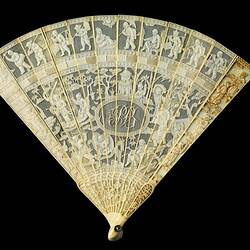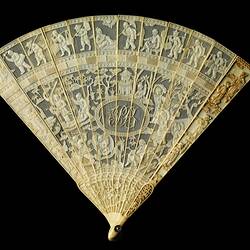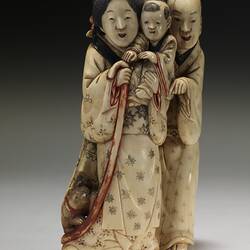Summary
Finely carved bone fan with scenes of Chinese figures set amongs trees and foliate motifs, manufactured in China during the late Qing Dynasty (1644-1912), circa 1880.
'Zhe Shan', or folding fans were introduced to China from Japan, via Korean Envoys, during the Song Dynasty (960-1279), and rose in popularity through the subsequent Ming (1468-1644) and Qing Dynasties (1644-1911), during which period it also become a symbol of social status. The eastern coastal city of Hangzhou in Zhejiang province established itself as an early centre of fan production and continues today to produce folding fans for the tourist and export markets.
Despite their increasing use during the Ming Dynasty, folding fans was initially perceived to be associated with those of lower social classes. Ming Dynasty writer and scholar, Lu Shen (c.1477-1545), recalls that early during the Dynasty envoys from south-eastern China were mocked and laughed at because they carried folding fans.
As with many forms of Asian art, the fans' shape and the scenes and motifs with which they were decorated were often rich in meaning, and the shape of the Zhe Shan - with its narrow base, widening at the top - presented an often challenging canvas for artists and calligraphers to decorate. Because of this, quality foldings fans with painted or inscriptions could be expensive, hence their association during the Qing Dynasty as an accessory for the upper social classes.
With the rise in popularity of 'Chinoiserie' (in the Chinese-style) in European decorative arts in the late seventeenth and eighteenth centuries, small items such as fans became a means to export Chinese culture to the West. This particular example offers a clear illustration of this practice, with the initials 'PB' carved in cursive script within an oval escutcheon in the centre of the fan, surrounded by the more traditional Chinese figures and design.
Physical Description
Finely carved fan, with intricately carved stems showing oriental scenes. A centre panel with initials PB . Traces of cream silk in upper third of stems.
More Information
-
Collection Names
-
Collecting Areas
-
Acquisition Information
Cultural Gifts Donation from Dr Will Twycross, 23 Jan 2009
-
Acknowledgement
Donated through the Australian Government's Cultural Gifts Program
-
Place & Date Made
-
Place & Date Exhibited
Royal Exhibition Building (REB), Nicholson Street, Carlton, Greater Melbourne, Victoria, Australia, 1880-1881
-
Collector
Mr John Twycross, Elsternwick, Greater Melbourne, Victoria, Australia, 1881
-
Inscriptions
A centre panel with initials PB
-
Classification
Royal exhibition building, International exhibitions, Exhibition heritage
-
Category
-
Discipline
-
Type of item
-
Overall Dimensions
17 mm (Width), 190 mm (Height)
*Measured when closed
-
Overall Dimensions - Folded
188 mm (Length), 24 mm (Width)
Measurement From Conservation.
-
References
Tsnag, Ka Bo, 'More than Keeping Cool: Chinese Fans and Fan Paintings', Toronto: Royal Ontario Museum, 2002. Qian, Gonglin, 'Chinese fans: artistry and aesthetics', Long River Press, 2000.
-
Keywords
Chinese Art, Exhibitions: Melbourne International, 1880-1881, Fans, Royal Exhibition Building



